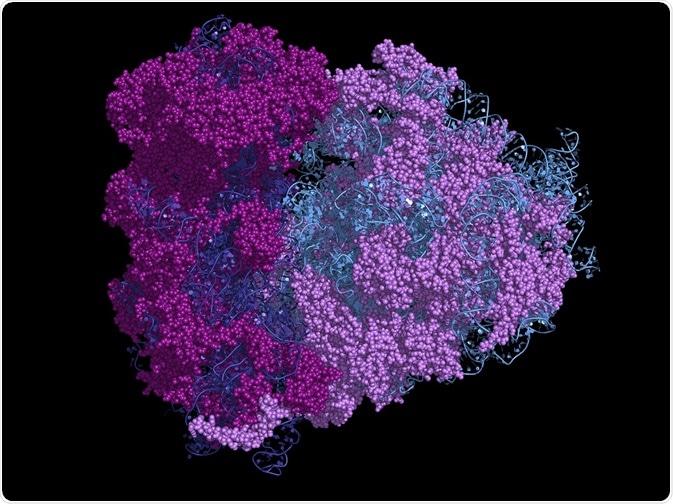By Jeyashree Sundaram, MBA
In eukaryotes, there are four rRNAs associated with ribosomes; these are the 18S, 5.8S, 28s, and 5S rRNAs. Production of the first three occurs within the nucleolus, whereas 5S rRNA production occurs in the nucleus, before exportation to the cytoplasm.
 Credit: petarg/Shutterstock.com
Credit: petarg/Shutterstock.com
The synthesis and processing of 18S, 5.8S, 28s rRNAs occurs within the nucleolus of the cell. These are first transcribed from a single pre-RNA transcription unit which encodes the three RNAs. The pre-RNA formed is much longer than the final rRNA due to non-transcribed spacers as well as transcribed spacer RNA on either side of the individual RNAs. All these are removed during processing to form the final mature rRNAs.
rRNA transcription
The single pre-rRNA transcription unit (pre-rRNA gene) induces the formation of a nucleolus and the other components of a ribosome diffuse to the newly formed pre-rRNA. Production of 5S rRNA occurs outside of the nucleolus, in the nucleus, but soon diffuses into the nucleolus to become part of the ribosomal subunit.
Nascent pre-rRNA molecules are immediately bound by proteins to form pre-ribonucleoproteins (pre-RNPs). From this point on, a set of coordinated processes take place to yield the final mature rRNAs :
- The bound pre-rRNA is cleaved at specific points to yield the final mature 18S, 5.8S, aand 28S rRNAs (found in ribosomes).
- Some of the proteins in the pre-rRNP remain part of ribosomal subunits, while others remain in the nucleolus to help in the formation of ribosomal subunits.
- The cleavage positions as well as the methylation and conversion of uridine residues are determined by small nucleolar RNAs (snRNAs).
- Both exons (those that represent an rRNA) and introns (those that do not represent an rRNA) are cleaved during the process. The introns are involved in the self-splicing of pre-rRNA, presumably through reactions of two transesterification methods in which energy input is not needed.
In a eukaryotic ribosome, there are two subunits, one larger and one smaller. The larger subunit of 60S is made up of 5S rRNA, 5.8S rRNA, 28S rRNA as well as 50 other proteins; whereas, the small subunit of 40S is made up of 33 proteins as well as 18S rRNA. When the ribosomal subunits have been assembled, they are transported to the cytoplasm.
tRNA modifications
As with rRNAs, mature tRNAs (70–80 nucleotides) are formed by cleavage of larger precursors called pre-tRNAs (about 350 nucleotides). Pre-tRNAs are subject to extensive processing, which involves cleavage, addition, and base modifications as indicated below:
- Cleavage of the leader sequence at the 5’ end of the pre-tRNA
- A sequence at the 3' end is also cleaved, but a CCA sequence is added soon after trimming.
- Modification of many nucleotides present in the pre-RNA is done. These include:
- Adding methyl as well as isopentenyl groups into the purine bases’ heterocyclic ring.
- In all the residues, the 2′-OH group present in the ribose will undergo methylation.
- Converting specific uridines to pseudouridine, dihydrouridine, or else ribothymidine.
- Certain introns in the pre-tRNAs are also spliced out.
The tRNA processing takes place in the nucleoplasm and are transmitted to the cytoplasm after maturation.
mRNA modifications
Eukaryotic mRNAs have a half-life of a few hours, while bacterial mRNAs last for about 5–10 seconds. The pre-mRNAs are first coated with RNA-stabilizing proteins during processing before being exported to cytoplasm.
Other aspects of pre-mRNA processing include the following:
- When the length of the pre-mRNA reaches 25 nucleotides, 7-methylguanosine cap is added to the 5' end of the growing chain. This process, which results in a 5-to-5 triphosphate bridge, is called capping, as it protects the pre-mRNA from degradation. The cap is later recognized by initiation factors, for translation.
- While transcription continues beyond the actual end of a gene, an endonuclease protein complex associated with the pre-mRNA cleaves the latter between an AAUAAA consensus sequence and a GU-rich sequence.
- Immediately after, a 200 nucleotide poly(A) tail is added to the 3¢-end of the pre-mRNA, by the enzyme poly(A) polymerase (PAP). This tail protects the mature mRNA from degradation during transportation to the cytoplasm, and also plays a role in protein binding during translation initiation.
- Introns present in the pre-mRNA are spliced out and degraded within the nucleus by a complex of proteins and RNA called spliceosomes. This removal process has the accuracy and precision of a single nucleotide.
Further Reading